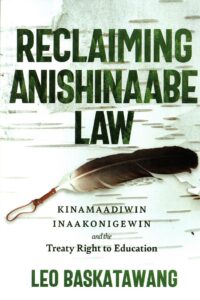Book review: Reclaiming Anishinaabe Law: Kinamaadiwin Inaakonigewin and the Treaty Right to Education
 Reviewed by Karl Hele
Reviewed by Karl Hele
Leo Baskatawang’s draws upon extensive research that prioritizes and centres the Treaty 3 Anishinaabe’s knowledge, sovereignty, and understanding of treaty. Baskatawang’s argument is grounded in the belief that Anishinaabe education must be guided, administered, and delivered by Anishinaabeg people. This is a sovereign right that is confirmed within Treaty 3, as well as the oral and written traditions surrounding its negotiation. Within his argument, Baskatawang challenges politicians, policy makers, settlers, and Indigenous peoples to recognize, affirm, and act upon the laws that have guided Anishinaabe society, specifically education, for generations. Simply, he maintains that now is the time to act on Indigenous control of Indigenous education and this can be done through treaty and reconciliation. Without Indigenous-centred education, the Anishinaabeg and all Indigenous peoples will remain unable to effectively engage in the good life.
Baskatawang’s work is structured around an Introduction and five chapters. The Introduction sets up the book, broadly outlining the arguments that will be developed in the subsequent chapters. Chapter 1 discusses “Colonization and Other Political Discontents”, and explores the failings of colonially-imposed education systems, social disruptions, attempts to destroy language and culture, as well as separate people from the land. He also weaves in Indigenous efforts to maintain or engage in survivance throughout the colonial assault.
Chapter 2, “Indigenous Laws and the State,” discusses the importance of treaty, as well as how recent Canadian Supreme Court decisions can impact how a treaty is read from a historical, contextual, Indigenous, and contemporary perspective to formulate a right understanding. The right understanding is not about rights, but about the right decision to pursue that which benefits and expands Anishinaabe education and will allow people to achieve a good life. This chapter, for me, is theoretically engaging and original for its discussion that ties education clauses within treaties to various court decisions and policy decisions since most treaty writing focusses on rights for governance, hunting, fishing, and taxation. It was wonderful to read an Indigenous-centric discussion about the sovereign, relational, and treaty right to education as a bundle.
Chapter 3 lays out Treaty 3’s approach to Kinamaadiwin Inaakonigewin (Education Law). Importantly, Baskatawang, in laying out the vision of Kinamaadiwin Inaakonigewin, offers a practical approach to its implementation by both the people of Treaty 3 and the government.
“Reconciliation as Recognition and Affirmation”, Chapter 4, is a further call for action. The core argument within Chapter 4 is that reconciliation will not take place through governmental lip service to treaty, section 34 of the Constitution, the Truth and Reconciliation Commission, or United Nations Declaration on the Rights of Indigenous Peoples (UNDRIP). According to Baskatawang, the state must recognize the Anishinaabe of Treaty 3’s right to implement their own educational policies structured on Indigenous law. The state can affirm Anishinaabeg implementation of Kinamaadiwin Inaakonigewin through policy, finance, and law.
Finally, in Chapter 5, “Reflections”, Baskatawang offers his final thoughts, predictions, and hopes for Indigenous education, as a right as well as the future of the Indigenous-Canadian relationship through reconciliation.
Reclaiming Anishinaabe Law is a wonderful study by Baskatawang. It is nicely argued, while combining the theoretical, Indigenous and European with the practical. I believe the first chapter could have been condensed, thereby allowing for a greater exploration of law, treaty, and education – but that critique reflects my interest in Indigenous and Aboriginal laws. The text of the book itself appears crowded due to the formatting and printing. This takes a few pages to become accustomed to, but it does not detract from Baskatawang’s writing style, arguments, and conclusions. It is a good educational read. Additionally, while the work focusses on the Anishinaabe who signed Treaty 3’s efforts to implement Kinamaadiwin Inaakonigewin, Reclaiming Anishinaabe Law offers larger lessons and potential pathways to reclaim control of an educational future for all Indigenous communities in Canada. Like Baskatawang, I too, recommend this monograph to policy makers, politicians, all levels of educators, and students of history, politics, law, education, and anthropology. I would also recommend anyone interested in reclaiming Anishinaabe Law and education in our communities read this book.
Leo Baskatawang, Reclaiming Anishinaabe Law: Kinamaadiwin Inaakonigewin and the Treaty Right to Education. Winnipeg: University of Manitoba Press, 2023.


